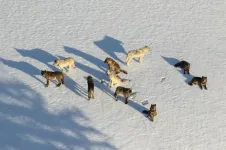(Press-News.org) UNIVERSITY PARK, Pa. -- By modeling wolves in Yellowstone National Park, researchers have discovered that how a population is organized into social groups affects the spread of infectious diseases within the population. The findings may be applicable to any social species and could be useful in the protection of endangered species that suffer from disease invasion.
Like other social carnivores, wolves tend to form territorial social groups that are often aggressive toward each other and may lead to fatalities. During these encounters, infectious diseases -- like mange and canine distemper -- can spread between groups, which can further reduce the number of individuals in a group.
"Previous social group-disease models have assumed that groups do not change throughout the course of an infection, when in reality, this is unlikely to be true," said Ellen Brandell, a recently graduated doctoral student in biology, Penn State. "Individuals within groups may die, become infected and recover at different rates, and the group may split into multiple groups or multiple groups could combine into one. Our models account for these processes and provide a foundation for exploring relationships for many social species that have varying levels of social complexity."
The researchers used demographic data from two decades of Yellowstone wolf research to create models for examining the effects of sarcoptic mange and canine distemper virus on wolves that accounts for both within-group and between-group processes. The models assume that disease processes, such as transmission rates, vary among groups and within groups.
The models also allow for the incorporation of Allee effects, a phenomenon in which a group has a greater survival rate when there are more individuals in the group.
"Allee effects are especially important in social species that require assistance from others beyond reproduction to survive; for example, in animals that defend themselves from predators and hunt for prey as a group," said Peter Hudson, Willaman Professor of Biology, Penn State. "When pathogens kill individuals, this can cause the growth rate of small groups to slow, or even collapse, which, in turn can cause the greater population to decline in size."
The team's model results, which appeared March 1 in the journal Proceedings of the National Academy of Sciences, revealed that pathogens reduce population size mainly through a reduction in the number of groups since those individuals are transmitting the disease to each other to a greater extent than they are to other groups within the overall population. At the same time, Allee effects are exacerbated within infected groups, which further reduces the probability of pathogen spread outside of groups as infected groups die out quickly. As a result, uninfected groups in the population grow slightly larger.
"This occurs because the rate of aggression between groups is reduced when the presence of the pathogen decreases the number of groups, which then allows healthy surviving groups to increase in size as they suffer lower rates of aggression," said Hudson.
However, the team found that the total population size is reduced as a result of the introduction of pathogens.
"In other words," added Brandell, "when a pathogen is in a population, we might see fewer, larger groups, but the overall population size is still reduced."
Importantly, the models demonstrated that low pathogen prevalence at the population level can mask high levels of prevalence within infected groups.
"This finding emphasizes the need for representative sampling in socially structured populations as pathogen outbreaks in unsampled groups can be missed," said Brandell. "Wildlife researchers and managers should sample from many groups in a population in order to accurately depict disease prevalence. For social carnivores, this means sampling across a larger area and monitoring many groups in a population."
Hudson emphasized the importance of recognizing that population-level prevalence tends to be lower than the number of groups infected and the level of infection experienced by individuals in infected groups.
"This issue should be a central consideration when wildlife disease biologists are analyzing and interpreting prevalence and seroprevalence data," he said. "It may be especially helpful in the protection of endangered species, such as African wild dogs."
INFORMATION:
Other authors on the paper include Andrew Dobson, professor of ecology and evolutionary biology, Princeton University; Paul Cross, disease ecologist, U.S. Geological Survey; and Douglas Smith, senior wildlife biology, Yellowstone National Park.
The U.S. Geological Survey and the National Science Foundation supported this research.
WESTMINSTER, Colorado - March 02, 2021 - Herbicide-resistant weeds have fueled a growing demand for effective, nonchemical weed controls. Among the techniques used are chaff carts, impact mills and other harvest-time practices that remove or destroy weed seeds instead of leaving them on the field to sprout.
A recent article in the journal Weed Science explores whether such harvest-time controls would be effective against downy brome, Italian ryegrass, feral rye and rattail fescue - weeds that compete with winter wheat in the Pacific Northwest. Researchers set out to determine whether ...
New research has found that shrimp like creatures on the South Coast of England have 70 per cent less sperm than less polluted locations elsewhere in the world. The research also discovered that individuals living in the survey area are six times less numerous per square metre than those living in cleaner waters.
This discovery, published today in Aquatic Toxicology, mirrors similar findings in other creatures, including humans. The scientist leading research at the University of Portsmouth believes pollutants might be to blame, further highlighted by this ...
Resveratrol is a plant compound found primarily in red grapes and Japanese knotweed. Its synthetic variant has been approved as a food ingredient in the EU since 2016. At least in cell-based test systems, the substance has anti-inflammatory properties. A recent collaborative study by the Leibniz Institute for Food Systems Biology at the Technical University of Munich and the Institute of Physiological Chemistry at the University of Vienna has now shown that the bitter receptor TAS2R50 is involved in this effect. The team of scientists led by Veronika Somoza ...
CHICAGO, March 2, 2021 -- More than 70 percent of dentists surveyed by the American Dental Association (ADA) Health Policy Institute are seeing an increase of patients experiencing teeth grinding and clenching, conditions often associated with stress. This is an increase from ADA data released in the fall that showed just under 60 percent of dentists had seen an increase among their patients.
"Our polling has served as a barometer for pandemic stress affecting patients and communities seen through the eyes of dentists," said Marko Vujicic, Ph.D., chief economist and vice president of the ADA Health Policy Institute. "The increase over time suggests stress-related conditions have become substantially more prevalent since the onset of COVID-19."
The ...
BOSTON - Lymph nodes in the armpit area can become swollen after a COVID-19 vaccination, and this is a normal reaction that typically goes away with time. Radiologists at Massachusetts General Hospital (MGH) who recently published an approach to managing this situation in women who receive mammograms for breast cancer screening in the American Journal of Roentgenology have now expanded their recommendations to include care for patients who undergo other imaging tests for diverse medical reasons. Their guidance is published in the Journal of the American College of Radiology.
"Our ...
A new study published today in the journal Geophysical Research Letters used NASA's ice-measuring laser satellite to identify atmospheric river storms as a key driver of increased snowfall in West Antarctica during the 2019 austral winter.
These findings from scientists at Scripps Institution of Oceanography at the University of California San Diego and colleagues will help improve overall understanding of the processes driving change in Antarctica, and lead to better predictions of sea-level rise. The study was funded by NASA, with additional support from the Rhodium Group's Climate Impact Lab, a consortium ...
CLEVELAND - Researchers from Cleveland Clinic's Global Center for Pathogen Research & Human Health have developed a promising new COVID-19 vaccine candidate that utilizes nanotechnology and has shown strong efficacy in preclinical disease models.
According to new findings published in mBio, the vaccine produced potent neutralizing antibodies among preclinical models and also prevented infection and disease symptoms in the face of exposure to SARS-CoV-2 (the virus that causes COVID-19). An additional reason for the vaccine candidate's early appeal is that it may be thermostable, which would make it easier to transport and store than currently authorized COVID-19 ...
There's more to taste than flavor. Let ice cream melt, and the next time you take it out of the freezer you'll find its texture icy instead of the smooth, creamy confection you're used to. Though its flavor hasn't changed, most people would agree the dessert is less appetizing.
UC Santa Barbara Professor Craig Montell and postdoctoral fellow Qiaoran Li have published a study in Current Biology providing the first description of how certain animals sense the texture of their food based on grittiness versus smoothness. They found that, in fruit flies, a mechanosensory channel relays this information about a food's texture.
The channel, called TMEM63, is part of ...
UPTON, NY--Physically confined spaces can make for more efficient chemical reactions, according to recent studies led by scientists from the U.S. Department of Energy's (DOE) Brookhaven National Laboratory. They found that partially covering metal surfaces acting as catalysts, or materials that speed up reactions, with thin films of silica can impact the energies and rates of these reactions. The thin silica forms a two-dimensional (2-D) array of hexagonal-prism-shaped "cages" containing silicon and oxygen atoms.
"These porous silica frameworks are the thickness of only three atoms," explained Samuel Tenney, a chemist in the Interface Science and ...
AMES, Iowa - Vaccines are an important tool in fighting porcine reproductive and respiratory syndrome (PRRS), but the fast-mutating virus that causes the disease sometimes requires the production of autogenous vaccines tailored to particular variants.
The production of autogenous vaccines depends on the ability of scientists to isolate the virus, but sometimes that's a tricky process. A new study from an Iowa State University researcher shows that a new cell line may offer a better alternative to the cell line most commonly used to isolate the PRRS virus. That could lead to more reliable processes for creating autogenous vaccines, but most autogenous vaccine producers would have to make dramatic changes to their processes ...







